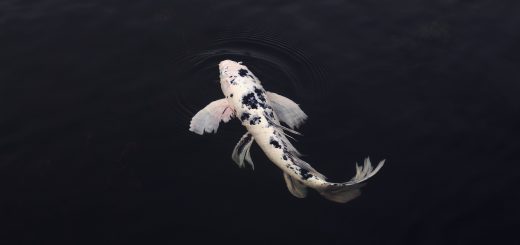Showa Sanke is the most wild and coolest of the Nishikigoi (koi).
Showa Sanke, which evokes the image of a strong Nishikigoi

When you buy a Nishikigoi, have you ever seen a Nishikigoi that has a cool pattern with a mixture of red, black and white?
The name of the type of Koi is called Showa Sanke, and it is a popular design among Nishikigoi.
This is a detailed explanation of the wildly cool Showa Sanke.
Showa Sanke is a cool and masculine pattern among Nishikigoi.

Showa Sanke is a well-balanced koi with red, black and white colors.
Black is also called sumi, and the good Showa Sanke has a black color like jet black .
It has a large black color and is characterized by a black color that goes all the way to the belly.
The difference between the Showa Sanke and Taisho Sanke.
There is also a similarly colored composition of Nishikigoi called Taisho Sanke.
The Taisho Sanke is relatively red and white with some black spots in each part.
The expression “black spots on a red and white carp” might be more appropriate.
In the case of the three Showa colors, the design is a mixture of black, red and white.
I like it because it’s a pattern, but I think the Showa Sanke is more rough and masculine.
In addition, Showa Sanke often has a black pattern on its face.
The Taisho Sanke is explained in more detail in “Taisho Sanke- Beautiful and serene patterns like an adult in Nishikigoi“.
For more information on the detailed differences between the Showa and Taisho Sanke and how to tell them apart, see “Differences between the Showa and Taisho Sanke : Tips on how to tell them apart“.
Showa Sanke’s Nishikigoi is one of the things I look forward to seeing in its unpredictable growth.
The pattern of Nishikigoi when they are young and after they have grown up can be very different.
That’s part of the fun of owning a Nishikigoi.
In particular, the three Showa shades have a lot of ups and downs in their colors.
The finish is unimaginable when you’re little, and the patterns sometimes appear so suddenly that you wonder if you’ve suddenly become a different fish.
Think of the Showa Sanke as a red and white base, and imagine how the black would come out.
In the Showa Sanke, the scarlet part (called Hiban), like the red and white part, is extremely unlikely to reappear once it has disappeared.
Therefore, it is important to think about how to put a highly variable ink part on the finished red part to some extent.
Some Koi, especially when they are small, don’t show much black , and at first glance you might think they are not Taisho Sanke or Kohaku.
Therefore, you don’t have to worry even if you think that the black part is a little short when you buy it.
What kind of Showa Sanke Koi will have a clear black color in the future?
There are two main points to recognize Nishikigoi.
The first is called “aoji” (blue ground), which is a vague, blueish black that appears underneath the white ground, and that area will become black in the future.
The blue ground is often hidden by the white, but there is often a hint of blue that is almost light blue.
I think the black will become clearer in the future.
In addition, it is said that if there is a black pattern on the pectoral fins, the black will appear clearly in the future.
It is a relief if there is a clear and dark ink at the base of the pectoral fins in particular.
It will be a good Showa Sanke in the future.
If you are concerned about these things and buy a small Showa Sanke, I think it would be interesting to buy a little unsatisfactory Koi at first and enjoy the changes as they grow.
What kind of high quality Showa Sanke carp are you talking about?
Choose a Nishikigoi whose ink quality (black area) is clearly visible in black.
I think it’s easier to understand if you describe it as jet-black or ink-like black.
The important point to note is that when you check the black part, it is important to check it in a bright place and to check the part where the base of the black part is white.
The black of the red part of the base is not white and tends to look dark inevitably.














Recent Comments